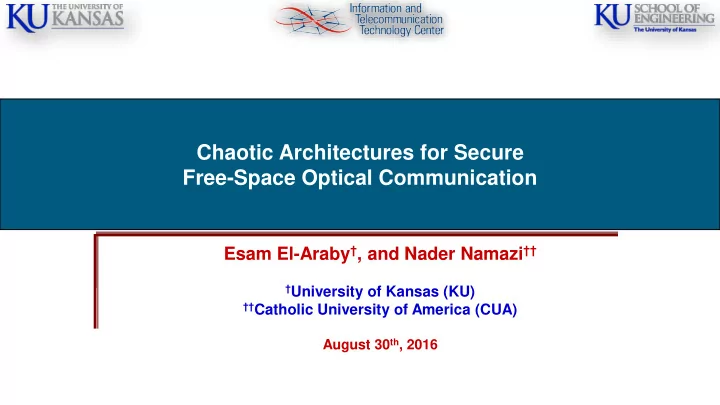

Chaotic Architectures for Secure Free-Space Optical Communication Esam El-Araby † , and Nader Namazi †† † University of Kansas (KU) †† Catholic University of America (CUA) August 30 th , 2016
Outline Introduction and Motivation Approach Implementation Architecture Results and Future Work Summary and Conclusions FPL 2016 – August 30 th , 2016 2
Introduction and Motivation Free-Space Optical (FSO) vs. Free- Space Radio-Frequency (FSRF) communications Larger Bandwidth Lower Cost, Power, Mass of implementation Improved Security Secure FSO communications Usually use laser N-slit-interferometers Over relatively short propagation distances, particularly for deep-space communication » Terrestrial applications Several kilometers » Space applications Several thousand kilometers (2,000-10,000 km) Security and Long-Range FSO communications NASA’s LLCD Conflicting requirements System FPL 2016 – August 30 th , 2016 3
Outline Introduction and Motivation Approach Implementation Architecture Results and Future Work Summary and Conclusions FPL 2016 – August 30 th , 2016 4
Approach Chaotic Systems First presented by E. N. Lorenz in 1963 Display well defined, but extremely complex dynamic behaviors Broadband noise-like signals similar to spread-spectrum signals Multi-path fading resistance Unpredictability Laser Communications Relay Demonstration (LCRD) Sensitivity to initial conditions Difficult for unintentional receivers to synchronize to the chaotic signal Security Pyramidal Filtering Structures Discrete Wavelet Transformation (DWT) Minimize scintillation noise » Usually found in space-to-ground, near-Earth, and terrestrial communications FPGAs Stringent real-time requirements of FSO communications Transmission Rates > 1 Gbps Bit-Error-Ratios (BER) < 10 -7 FPL 2016 – August 30 th , 2016 5
Outline Introduction and Motivation Approach Implementation Architecture Results and Future Work Summary and Conclusions FPL 2016 – August 30 th , 2016 6
Proposed System Architecture FPL 2016 – August 30 th , 2016 7
Chaotic Transmitter & Receiver FPL 2016 – August 30 th , 2016 9
Chaotic Transmitter & Receiver Lorenz Chaotic Transmitter Lorenz Chaotic Receiver FPL 2016 – August 30 th , 2016 10
Peak Detector & Data Synthesizer/Reconstructor Peak Detector Data Synthesizer/Reconstructor FPL 2016 – August 30 th , 2016 11
Outline Introduction and Motivation Approach Implementation Architecture Results and Future Work Summary and Conclusions FPL 2016 – August 30 th , 2016 12
Results Performance and FPGA Resource Utilization of a Single-Engine Prototype FPGA Device: xc6vlx240t Package: ff1156 Speed Grade: -1 Utilization FPGA Resource Used Available (%) 630 301,440 1 Slice Registers Slice LUTs 958 150,720 1 368 37,680 1 Occupied Slices RAMB36E1 6 416 1 ML605 Board (Virtex-6 FPGA) DSP48E1 24 768 3 Bonded IOBs 51 600 8 Detection Precision (bits) 28 Clock Frequency (MHz) 200 Throughput (Gbps) 5.6 FPL 2016 – August 30 th , 2016 13
Results Real Dataset Representing FSO Scintillation Noise (Obtained from the US Naval Research Laboratory) Aperiodic NRZ Data Transmitted Over a Noisy FSO Channel (SNR = 20dB) Bit-Error-Ratio (BER) at Different Noise Levels FPL 2016 – August 30 th , 2016 14
Summary and Conclusions FSO and Chaotic systems combined Longer-range communication Inherent security in chaotic systems Targeting both space and terrestrial applications Haar DWT employed Attenuate the undesired effects of FSO channels Relative success based on static thresholding Bit-Error-Ratio (BER) measured Different levels of noise of different types, such as scintillations and additive white Gaussian noise (AWGN) with zero-mean FPGAs proposed Could comfortably accommodate the stringent real-time requirements of FSO Prototyped utilizing Xilinx Virtex-6 ML605 board Future work Improving BER using adaptive thresholding and optimized peak detection Increasing the dynamic range of the system, e.g. SNR ranging from -20 dB to 50 dB Investigating Doppler effects Investigating chaotic masking Interfacing with FSO optics Integrating with LCRD and other NASA missions FPL 2016 – August 30 th , 2016 16
FPL 2016 – August 30 th , 2016 17
Recommend
More recommend